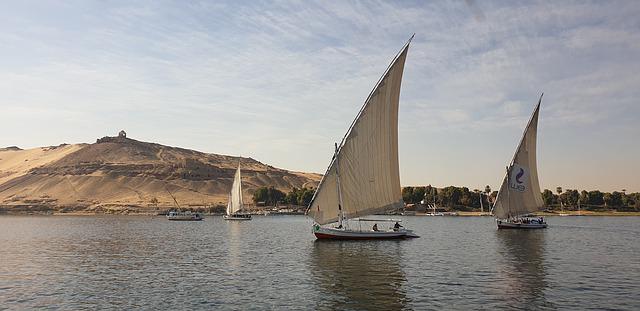Facts And Figures About River Nile

From the start of human civilization, the famous Nile River has supported many livelihoods and fascinated a lot of people globally. Stories about the river are deeply engraved in history, dating back thousands of years when our ancestors benefited from the river’s many resources. This post briefly discusses the role of the Nile River and shows how anyone visiting Egypt can take pride in the river and appreciate its numerous ancient attractions.
Its Geographical Location, as well as Key Figures
The river’s course flows north, cutting through northeast Africa and the Nile Delta in Egypt, finally terminating at the Mediterranean Sea. Along its path, it meanders through ten other countries: Tanzania, Kenya, Eritrea, Uganda, Ethiopia, Rwanda, Burundi, the Democratic Republic of the Congo, South Sudan, and the Republic of Sudan. The River Nile also passes through major geographical landmarks on the African continent, including Lake Victoria, Lake Albert, Murchison Falls, and the Blue Nile Falls.
The River’s Tributaries
The Nile has three main tributaries – the White Nile, the Blue Nile, and the Atbara River, which has less input than the initial two. To identify the origin of the major river, we need to investigate the source of each Nile’s tributary.
The origin of the White Nile has not been established conclusively but is thought to be somewhere between Rwanda and Burundi. Nonetheless, the White Nile is the longest tributary of the Nile and accounts for 20% of the Nile’s total waters. The Blue Nile sets off from Lake Tana in Ethiopia and cuts through Ethiopia and Sudan before it joins the White Nile at the convergence situated north of Khartoum in Sudan. Lake Tana in Ethiopia also serves as the source of the River Atbara. I would highly recommend taking a look at MS Royal Viking Nile cruise ship.
The length of the river Nile is estimated to be about 6,650 kilometers—the precise measure often varies. However, it is the longest river in Africa and possibly the longest in the world (some accounts presume the Amazon River to be longer). Indeed, the Nile is not the broadest river; it is relatively narrow, meaning it holds a much smaller volume of water than some of the big rivers in the world. For instance, the Congo River has a greater volume of water than the Nile.
The River Nile’s drainage basin measures over 3.3 million square kilometers, equaling one-tenth of Africa’s total continental area
The Nile During Ancient History
The Nile’s history can be traced back many years ago, with the river attaining its position as a significant water resource about 31 million years ago. Records show that the river was longer than it is currently. This was partly because Lake Tanganyika drained into the River Nile, which extended its water to Zambia. Nonetheless, the rise of the Virunga Mountains near the Rwandan border with Uganda and the Democratic Republic of Congo discontinued this tributary.
Over the past thousands of years, the story of the Nile has become completely intertwined with Egyptian culture. However, it is fascinating to note that the former flow of the river had sidestepped Egypt and cut through Libya before it terminated at the Gulf of Sidra. However, the river took its present course towards the end of the latest ice age, which caused the volume of water in the seas to increase. Hitherto, the river has been a significant water source, supporting many lives all over Egypt and Sudan.
The Role Of The Nile In Prehistoric Egypt
Certainly, many of Egypt’s socio-economic activities have been based on the banks of the Nile due to the river’s strategic location and exciting features. Most old cities and monuments grew on the banks of the Nile because people could access drinking water, fishing grounds, bathing spots, transport hubs, and recreation facilities thanks to the river. For instance, the Egyptians used waters from the Nile to develop sophisticated irrigation systems for the growth of crops in an area in northeast Africa with vast arid and desert conditions.





0